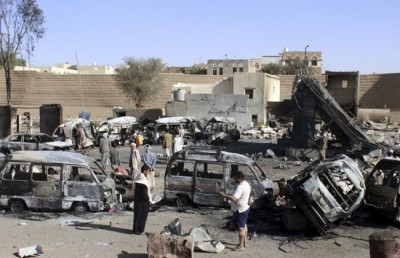
GR Editor’s Note
This report largely provides information pertaining to civilian casualties. It does not however address the underlying causes of the war, nor does it name the foreign powers which instigated the bombings.
* * *
Yemen is the worst country for civilian deaths and injuries from explosive weapon use in the first seven months of 2015, says a new publication produced by UK-based charity AOAV and UN OCHA.
In March 2015, a complex and long-running political crisis in Yemen rapidly escalated into all-out conflict. President Hadi fled the country after Houthi rebels took control of the capital city Sana’a, and on 26 March a coalition led by Saudi Arabia began an operation of air strikes in Yemen at the request of the Yemeni Government [in exile]. The fighting in the country since March has been characterised by the use of heavy explosive weapons in populated areas by all parties to the conflict, with civilians suffering from near-daily bombing and shelling in their towns and villages.
As of 10 September 2015, the UN Office of the High Commissioner for Human Rights (OHCHR) had registered 2,204 civilian deaths and 4,711 civilian injuries from all forms of armed violence in Yemen. Millions more have suffered from additional devastating consequences in the country, including poverty, malnutrition, insecurity, and limited access to health and sanitation.
Much of this chaos is due to the use of explosive weapons with widearea impacts in populated areas across the country.
In State of Crisis, AOAV and OCHA investigate the humanitarian impacts of the use of explosive weapons in populated areas in Yemen during the conflict up to 31 July 2015.
Key findings
Between 1 January and 31 July 2015 AOAV recorded:
- 124 incidents of explosive violence in Yemen resulting in 5,239 deaths and injuries;
- 86% of those killed and injured were civilians (4,493);
- More civilian deaths and injuries from explosive weapons were recorded in Yemen during the first seven months of 2015 than in any other country in the world;
- When explosive weapons were used in populated areas, civilians made up 95% of reported deaths and injuries;
- 13 separate incidents in Yemen each killed and injured more than 100 civilians. Eight of these incidents were air strikes;
- Air strikes have killed and injured the most civilians, with 2,682 civilian deaths and injuries (60%).
The impact of explosive weapons in Yemen goes far beyond the immediate deaths and injuries recorded by AOAV. The report uses testimonies and experiences of victims and witnesses to illustrate some of the long-term impacts that can cause extensive suffering far into the future, even after the fighting ends.
Robert Perkins, author of the report, says: “Our findings show Yemen is the worst country in the world this year for civilians affected by explosive violence, more devastating even than the crisis in Syria and Iraq. An already vulnerable population is now faced with a country reduced o rubble by falling bombs and rockets. Their homes destroyed, their families torn apart, it will take a many years to recover from the last few terrible months in Yemen.
The crisis in Yemen shows exactly why explosive weapons with wide-area effects have no place being used in populated areas. All parties to this conflict must immediately stop the bombing of civilians and civilian areas.”
To read the full report please click here.
For more information please contact [email protected].
Source Article from http://www.globalresearch.ca/state-of-crisis-explosive-weapons-in-yemen/5478360
Views: 0
 RSS Feed
RSS Feed

















 September 27th, 2015
September 27th, 2015  Awake Goy
Awake Goy 
 Posted in
Posted in 
















